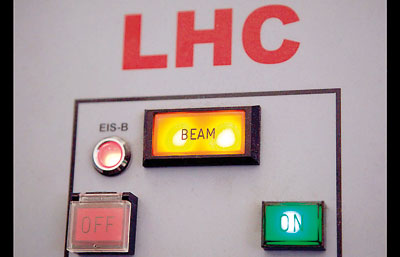Sunday Times 2
CERN scientists discover two new particles
Scientists at the Large Hadron Collider (LHC) in Cern, Geneva say they have discovered two new subatomic particles by smashing protons together.
The two new particles, called Xi_b’- and Xi_b*, were previously predicted to exist but had never been seen before.
It’s hoped the discovery could shed more light on how the universe works beyond the currently accepted models of physics.

Switches in the Control Room of the Large Hadron Collider at the European Organisation for Nuclear Research (CERN) near Geneva .The Large Hadron Collider in Geneva has discovered two new particles. The discovery was made by smashing protons at 99.9999% the speed of light The two new particles are called Xi_b'- and Xi_b* and are each six times more massive than a proton (Reuters)
The new particles were created by firing protons around the 17-mile (27km) tube of the LHC, specifically the Large Hardon Collider Beauty (LHCb) experiment.
They were then smashed together at 99.9999 per cent the speed of light, replicating the conditions at the Big Bang
As the protons collide, huge energies are released and previously unseen particles can be created and detected for a fraction of a second.
Discovering new particles isn’t that rare at Cern – Dr Patrick Koppenburg from the Netherlands’ Nikhef Institute told the Wall Street Journal that three to five are discovered every year. But, he added: ‘Here we have two in one go, which is quite extraordinary.’
The new particles discovered are known as baryons, and are made up of smaller subatomic particles called quarks.
Quarks are among the smallest particles known to exist that make up all other particles, known as elementary particles.
There are six different types of quark, and combining them together in different combinations produces larger particles.
Baryons include some of the more massive subatomic particles, such as protons and neutrons, that make up most of the visible matter in the universe.
But while particles like protons and neutrons are ever-present in the modern universe, other particles decay rapidly and are harder to spot.
That is what scientists at Cern have been investigating – namely, over the past few years they have smashed particles together at close to light speed to simulate the conditions of the Big Bang.
By creating a replica cosmic ‘primordial soup’ they are able to create some of the particles that were present at the Big Bang but do not exist today.
A loose analogy would be smashing an apple and a pear together at the speed of light, and seeing a strawberry flash into existence for a tiny fraction of a second.
In this latest research the new X_iB particles are made of one ‘strange’, one ‘down’ and one ‘bottom’ (or beauty) quark.
They were created by smashing together protons, but were found time be six times as massive as a proton.
Each of the two new particles also had it’s own ‘spin’, which basically explains how they interact with magnetic fields.
It was found that the spin of the lighter strange and down quarks in the Xi_b*- particle were aligned, while in the Xi_b’- particle they pointed in opposite directions – making the former slightly heavier.
Scientists hailed the discovery of the two particles as an important moment for physics that would help them further understand the universe at a subatomic level.
‘Nature was kind and gave us two particles for the price of one,’ said Dr Matthew Charles of the CNRS’s LPNHE laboratory at Paris VI University.
© Daily Mail, London

